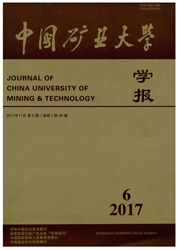

 中文摘要:
中文摘要:
基于对沁水盆地柿庄南区块煤层气井产出水连续3 a按季度采样和水质测试,采用多元统计分析和绘制Piper图、Schoeller图等方法,分析了煤层气井产出水的化学特征及离子变化规律.研究表明:柿庄南区块煤层气井产出水矿化度变化于661~5 572 mg/L之间,阳离子以K^++Na^+为主,Mg^2+,Ca^2+居次,阴离子以Cl^-为主,HCO3^-,SO^2-4居次.与累积排水量(或排采时间)相关的地下水混合作用是控制煤层气井产出水化学特征变化的主因,随排水量增加,矿化度、K^++Na^+,Ca^2+,Mg^2+,NH4^+,Cl含量呈幂函数形式减少,在piper图中各主要离子相对毫克当量基本呈线性变化.煤层气井产出水水型也呈规律性变化,由排采初期的Na-Mg-Cl型,转化为Na-Cl型、Na-HCO3-Cl型,约排采400 d或累积排水量达1 200 m^3后,水型基本稳定为Na-Cl-HCO3型.由此确定煤层气井产出水反映原始含水层或补给水层水化学特征的基本标准为排采超过400 d或排水量大于1 200 m^3,指出排采400 d或排水量达1 200 m3后,3#,15 #和3 #+15 #煤层产出水化学离子含量差别不大,15 #煤层主要以Mg^2+,Cl-和SOi-含量变化范围小区别于3 #和3 #+15 #煤层.
 英文摘要:
英文摘要:
Based on more than three years of continuous (quarterly) sampling and quality test of the coproduced water of CBM wells in Shizhuang south block, Qinshui basin, the chemical characteristics and ion variation of the coproduced water were analyzed by multivariate statistical analysis, Piper map and Schoeller map. The results show that the salinity of the coproduced water in Shizhuangnan block is in the range of 661 mg/L to 5 572 mg/L, the cation is mainly K^+ +Na^+ followed by Mg^2+ and Ca^2+ , and the anion is mainly Cl followed by HCO3^- and SO4^2-. The primary controlling factor of the regularity changing of the hydro-chemical characteristics of the coproduced water is the mixture effect of groundwater, which is related with the cumulative water discharge (or drainage time). The salinity and the ion contents of K^+ +Na^+ , Ca^2+ , Mg^2+ , NH4^+ and Cl^- decrease in the power function form with the increase of water discharge. Meanwhile, the relative milli-equivalent of the major ion basically changes linearly in the Piper map. The water types of the coproduced water of CBM wells also change as follows: the Na-Mg-Cl type in the initial stage of the water discharge, then being the Na-Cl type, and finally becoming the Na-HCO3-Cl type. And the Na-Cl-HCO3 type remains stable after the dis- charge of 400 days or more than 1 200 m3 cumulative water. It is concluded that the hydro-chemical characteristics the coproduced water of CBM wells can reflect that of the in-situ aquifer or the supply aquifer after the CBM wells discharge of 400 days or more than 1 200 m3 cumulative water. In Shizhuangnan block, there are no obvious difference in ion contents of the Nos. # 3, # 15 and # 3+ 15 coal seams eoproduced water after the CBM wells discharge of 400 days or more than 1 200 m3 cumulative water. Specially, the coprodueed water of the # 15 well can be distinguished with the # 3 and the # 3 + # 15 coal seams coprodueed water based on the smaller ion concentration variation of Mg^2+, Cl^-
 同期刊论文项目
同期刊论文项目
 同项目期刊论文
同项目期刊论文
 Evaluation of geological features for deep coalbed methane reservoirs in the Dacheng Salient, Jizhon
Evaluation of geological features for deep coalbed methane reservoirs in the Dacheng Salient, Jizhon 期刊信息
期刊信息
